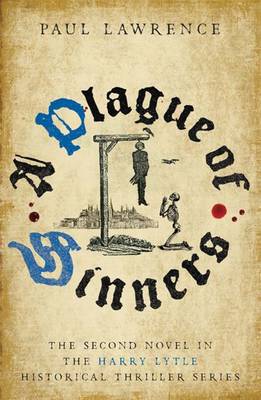
EURO CRIME
Reviews

Lawrence, Paul - 'A Plague of Sinners'
Paperback: 442 pages (May 2010) Publisher: Beautiful Books ISBN: 1905636911
It is the year 1665 and the great bubonic plague* rages rampant outside London's city walls. Harry Lytle lives in London at this time and is under orders from Lord Arlington on behalf of King Charles Stuart. Arlington asks him to investigate the death of the Earl of St. Albans. A death not from the plague but a rather grisly murder. With his faithful companion, Davy Dowling the butcher, accompanying him he sets off on a rather sinister adventure in which there are a number of other barbaric murders before the thrilling conclusion is reached.
This is a very unusual but definitely most atmospheric, historic thriller set in a period that seems rather neglected by other authors but which this writer seems to now inhabit and produce lots of fascinating detail. I enjoyed this book very much as it was so extraordinary, but there are some attempts to lighten the dark and sombre mood with gallows humour of the type that policemen and undertakers favour.
This author appears to have meticulously researched the period, and the sense of time and place permeate the book and I felt completely transported back to 1665 and lost my thoughts and worries concerning the present, during the periods I spent reading this book and if an author can succeed in doing that, than he an important writer indeed! If you enjoy good historical mysteries then you should read this book.
*This plague was terrifying because it struck so swiftly. Victims died within days, in agony from fevers and infected swellings. It spread at a horrifying fast rate, too, and could ravage a town or even a city within weeks. With no cure, the authorities relied on rather drastic methods to contain it. Many continental countries built large plague hospitals - 'pest houses' - to hold victims, but England preferred cheaper local solutions. Its 'plague orders' decreed that victims should be shut into their own houses and left to die. Victims were shut into their houses and the doors were nailed shut and marked with a large red cross. Nurses were hired to take in food and carry out basic care, and guards were set on watch to make sure that the sick (or their families) did not escape. The first victim died in May 1665 but as the weather was unusually hot and the plague germs spread very fast, thousands were soon too perish. Bells were toiling almost continually, announcing more deaths. You would see carts moving up and down the streets at night collecting the dead bodies. Large communal graves were dug to isolate the corpses. In all, 15% of the population perished during that terrible summer.
The germs were spread by vermin and the rat population was usually kept in check by domestic cats and dogs. These were not usual times and unfortunately the population at large believed the germs were spread by not rats, but their pet cats and dogs and so they proceeded to slaughter them. Of course the consequence was the rat population was left unchecked and the disease spread more rapidly, particularly in the hot, humid conditions of the summer. When, the cold winter arrived the deaths stopped.
Terry Halligan, England
November 2010
More European crime fiction reviews can be found on the Reviews page.